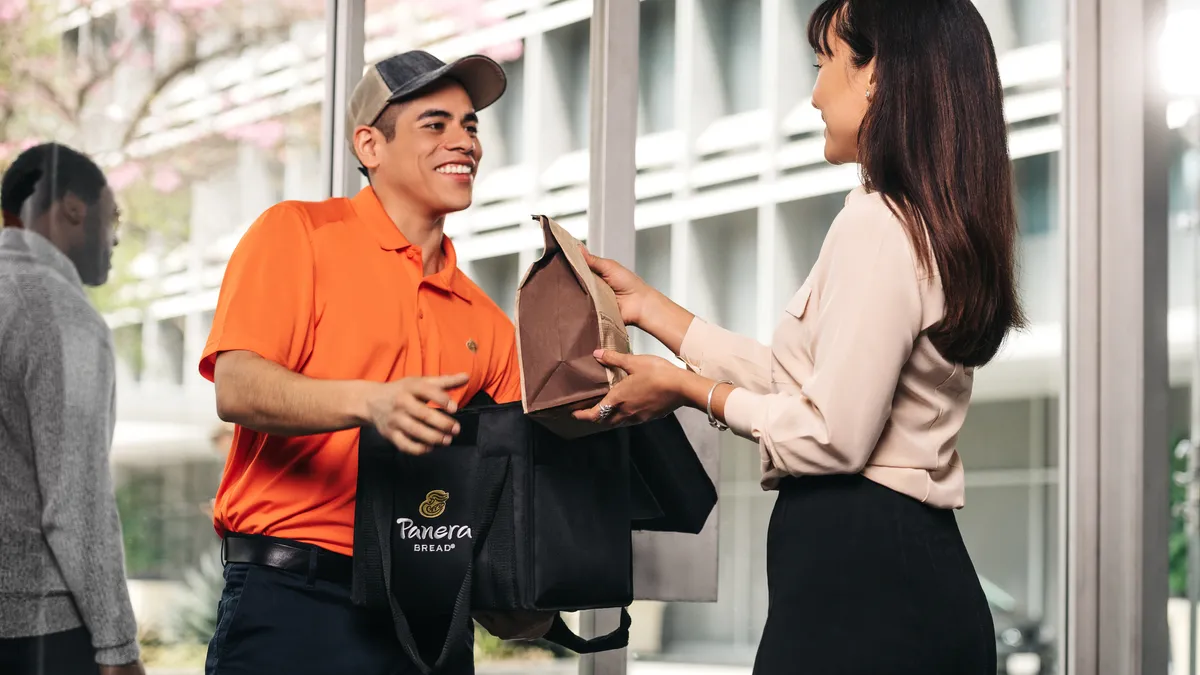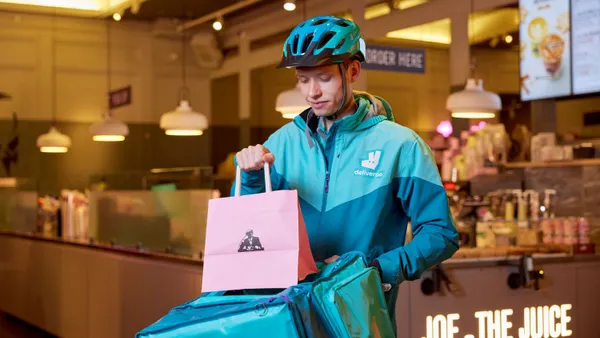Dive Brief:
- Panera has ended its pioneering self-delivery program that it launched in 2016, Restaurant Business reports. The fast casual chain told the publication it began phasing out its channel during the pandemic even as delivery sales grew materially. Panera did not respond to requests for comment by press time.
- Chris Correnti, SVP of off-premise channels, said the pivot away from self-delivery "enables Panera to offer a broader delivery range to serve increased demand for delivery, in response to an off-premise market that has grown and shifted dramatically over the past year."
- In 2019, Panera partnered with DoorDash, Grubhub and Uber Eats to expand its off-premise footprint, but continued to leverage its own fleet in most markets. At the time, the restaurant said sticking to its own delivery solution made sense economically, but that these channels offered more points of access, particularly to residential diners and evening daypart orders.
Dive Insight:
When Panera first introduced in-house delivery in 2016, it offered the channel at about 15% of its 2,000 locations at the end of that year. In 2017, it hired 10,000 delivery drivers and cafe employees to bolster the program, which helped the chain manage its delivery costs.
During the past year, Panera's delivery business has grown by more than 100%, the company told Restaurant Business. Its sales mix also reached mid-double digits, and over half of the chain's sales now come through off-premise channels, which also include pickup, drive-thru and curbside. Comparatively, in 2018, digital sales made up 29% of the company's business.
Chains of Panera's size are typically able to negotiate lower delivery commission fees because of the sales volumes they generate. Panera was the 10th largest U.S. chain in 2019 with 2,160 units and sales estimated to be about $5.9 billion, according to Technomic. That's not to say that major restaurants don’t feel the impact of third-party delivery fees, however, which can be as high as 30%.
In fact, Panera is one chain that has raised menu prices specifically for delivery orders, averaging 12% higher checks. If Panera's customers have proven they're willing to pay these higher prices for delivery, that gives Panera good case for shifting entirely to third-party delivery, especially since the labor market is currently a challenge for restaurants and wages are increasing across many markets.
Those two pressures could deter delivery hybrid models across the industry, as chains may be enticed by delivery platforms' nationwide penetration and as consumers continue to habituate toward third-party apps. The pandemic, for example, more than doubled third-party delivery app revenue between April and September 2020, even as consumers became more mindful of ordering directly from restaurants.
Even with the benefits third-delivery partnerships can bring, Panera's operations change comes as a surprise. The restaurant has served as a model for its profitable, in-house delivery for five years and leveraged its own infrastructure even as it added aggregate partnerships. In 2019, Panera's chief growth and strategy officer Dan Wegiel told Forbes that the partnerships were "only possible because we have our own network of drivers. It was critical that we retained our own drivers — for both the service experience, as well as the economic benefits."
It's also interesting that Panera didn't take the same approach as Jimmy John's in using DoorDash's self-delivery product, which enables restaurants to generate demand on DoorDash's market-leading marketplace while using their own drivers.












